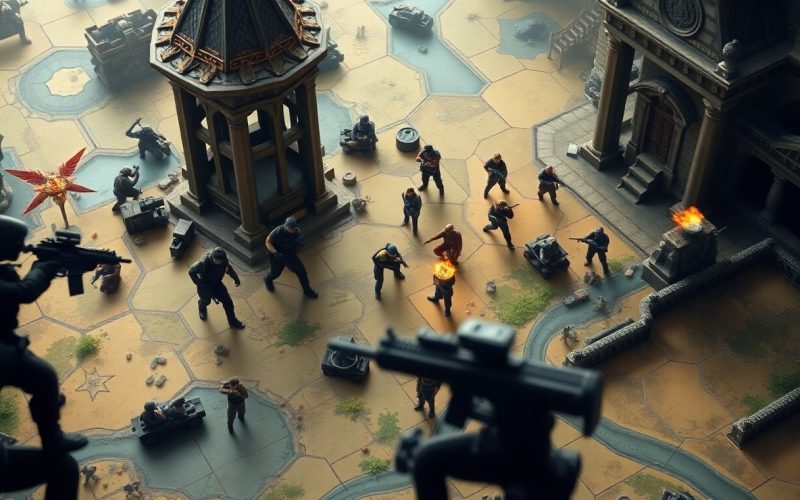There’s a lot that goes into securing a win in Valorant, and understanding map control is key to outsmarting your opponents. By mastering the layout of each map and coordinating with your teammates, you can create advantageous positions that lead to victory. In this blog post, we’ll explore effective strategies for map control, helping you dominate the battlefield and boost your overall performance. Whether you’re new to the game or looking to refine your skills, these tips will elevate your playstyle and enhance your chances of success!
Basic Map Control Fundamentals
Before submerging into advanced strategies, it’s vital to grasp the basic principles of map control in Valorant. Understanding map control means recognizing how to dominate key areas of the map to secure tactical advantages and limit your opponents’ movements. Effective map control leads to better information gathering and allows your team to operate with confidence, knowing where the enemy might be. Whether you’re holding a site, taking control of mid, or pushing for a flank, these fundamentals form the backbone of your team’s success.
Understanding Map Zones and Callouts
Any seasoned Valorant player knows that map knowledge is half the battle. Familiarizing yourself with different map zones and specific callouts can significantly enhance your gameplay. Each map is divided into distinct areas such as sites, mid, and choke points, and understanding these zones can help you strategize better during each round. Being able to communicate with your teammates using precise callouts will not only improve coordination but also boosts your team’s overall efficiency in both offense and defense.
Communication and Team Coordination
Communication plays a vital role in achieving effective map control. Your team needs to consistently share information about enemy positions, engage in strategic discussions, and call out plans as they unfold. Having clear and concise communication helps to minimize confusion and keeps everyone on the same page, maximizing your chances of seizing the map and pushing for victory. Whether you’re using voice chat or in-game ping systems, ensuring everyone understands their roles and objectives will make all the difference in your gameplay experience.
Fundamentals of teamwork extend beyond just verbal communication; it also includes understanding your teammates’ playstyles and adapting to them. By coordinating utility usage, setting up crossfires, and covering one another during pushes, you create a more solid front against the enemy. Synergy among teammates is key, so adapting your strategies in real-time based on your team’s strengths will often lead to successful rounds where you systematically take control of the map.
Essential Map Control Tactics
Assuming you want to maximize your chances of winning in Valorant, understanding how to effectively control the map is fundamental. Proper map control sets up opportunities for engagement and can dictate the momentum of the game. You can take advantage of various tactics to outmaneuver your opponents, secure site control, and create advantageous positions for your team throughout a match.
Setting Up Crossfires
Control is an necessary element when establishing crossfires on the map. By positioning two or more teammates in a way that they can support each other from different angles, you create a setup where enemies are at a disadvantage. This tactic not only makes it harder for foes to engage effectively but also allows for quick reactiveness should one player need help. Coordinate with your teammates to ensure lines of sight are covered, and always be mindful of movement to avoid being caught off guard.
Another element to consider is the use of off-angles, where players can position themselves in less expected spots. This unpredictability can greatly enhance the effectiveness of crossfires since enemies may be caught by surprise, leading to easy eliminations. Keeping communication open about positioning can further create opportunities to capitalize on enemy mistakes during engagements.
Utility Usage for Area Control
Essential to controlling areas of the map is your team’s proficiency with utility. Abilities ranging from smokes and flashes to molotovs and drone recon can significantly influence how you manage map segments. Using these tools to block vision or deny enemies access to crucial points allows your team to establish dominance in critical zones. Be strategic in deploying your resources to ensure maximum effectiveness during engagements or when securing sites.
Tactics such as using smokes to obscure sight lines or deploying recon abilities to gather intel on enemy movements are vital for overall map control. It’s not just about blocking areas; it’s about creating opportunities and ensuring your team can move safely. Effective utility placement can slow down or completely halt enemy advances and allow you to reposition strategically or initiate a push when the moment is ripe.
Rotation Timing and Management
Against a well-organized team, timely rotations can drastically impact the outcome of a round. Understanding when to rotate—whether to assist teammates or secure a position—can keep your advantage intact. It’s important to pay attention to the intel coming from your teammates and the overall game flow; if one side is taking heavy fire, it’s often worth coordinating a swift shift to provide backup or simply cover more ground on the map for your team.
Also, considering how quickly the enemy can rotate is important as well; balancing your own timing with knowledge of theirs ensures you’re never caught out of position. This synergy can be a differentiator in matches, leading to more successful holds or pushes as a unit. Engage with your teammates frequently about positioning and timing to ensure your approach is coherent and in line with your overall strategy.
Attack-Side Map Control
Now that we understand the importance of map control in Valorant, let’s explore how to effectively gain and utilize it while on the attack side. Securing map control early gives your team a solid foundation for executing strategies and can often lead to advantageous situations. Effective communication and coordination with your teammates are necessary components for successfully asserting dominance over key areas of the map. By fostering a proactive approach, your team can pressure the enemy, disrupt their plans, and seize potential opportunities for success.
Taking Map Control Early
An effective way to begin your attack is by taking map control early on in the round. This involves pushing forward to key locations such as mid, B-site, or A-main, depending on your team’s strategy. Engaging in early skirmishes can catch the enemy off guard, allowing you to claim important territories before they have time to set up their defenses. Furthermore, this initial aggression can force opponents to rotate, which creates openings for your teammates to exploit, potentially leading to an advantageous engagement.
Creating and Maintaining Space
Before venturing into engagements, it’s crucial to focus on creating and maintaining space on the map. This means actively pushing back the enemy while also ensuring your team holds onto the areas you’ve secured. Utilizing agents with abilities that can gather information or control regions—like smokes, flashes, and utility—can make a significant impact. Keeping the enemy guessing and unsure of your next move can set the stage for a successful attack and maximize your chances of winning fights and objectives.
Indeed, creating and maintaining space is not just about gaining territory; it also involves sustaining control throughout the match. This means being vigilant and responsive to potential enemy pushes as the round progresses. Rotating and shifting focus between different areas keeps the enemy on their toes and can lead to mistakes on their part. Teams that excel at this often create a snowball effect, as they force the opposition to react rather than act, ultimately tilting the game in their favor.
Defense-Side Map Control
Despite the aggressive playstyles often seen in Valorant, mastering defense-side map control can be a game-changer for your team. Holding onto key areas of the map not only provides vital information but also allows for effective rotations and strategic power plays. By locking down necessary positions, players can thwart enemy pushes and create a significant advantage for their team as the rounds progress.
Holding Key Positions
Behind every successful defense strategy is the ability to maintain key positions on the map. This means placing players in locations that provide both visibility and cover, allowing them to gather intel on enemy movements while being ready to engage. Popular spots, like A Site’s default corner or B Site’s back ramp, can often be game-deciders. It’s important to communicate effectively with your teammates to ensure that each critical area is adequately covered and that you can assess where the enemy is heading at any given moment.
Retake Strategies and Setup
About those situations when the enemy has managed to plant the spike, it’s necessary to have a well-coordinated retake strategy. This involves regrouping as a team, utilizing utility to clear out common hiding spots, and communicating effectively to minimize the risk of being surprised by lurking enemies. Creating crossfire setups can also make a difference, allowing for effective trades if a teammate is taken down during the retake.
Another great tip for retake setup is to use agents’ abilities to control space and deny enemies positions. For example, a character like Omen can use his smokes to obscure enemy vision, while a Sova can gather information with his recon dart. By combining utility effectively, you can make your retake a powerful force to be reckoned with and regain control of the site quickly after the spike has been planted.
Agent-Specific Control Strategies
Not all agents in Valorant are created equal when it comes to map control, and understanding how to leverage their unique abilities can significantly impact your gameplay. Agent-specific control strategies involve utilizing the strengths of each role—Controllers, Duelists, Sentinels, and Initiators—to establish dominance over the battlefield. Players should aim to seamlessly integrate their skills into the broader team strategy, ensuring that map control is not just a personal goal, but a group effort that fosters collaboration and synergy.
Controller Agents Map Control
After selecting a Controller agent like Brimstone, Viper, or Omen, your primary focus should be on smoke screens and area denial. These agents excel at obscuring enemy vision and cutting off key sight lines, allowing your team to navigate the map more effectively. For instance, Brimstone’s Sky Smoke can create a safe pathway for your teammates to push or rotate, while Viper can set up zones of control using her Toxic Screen and Poison Cloud abilities. Understanding the layout of each map enables you to place these abilities strategically, making it harder for the enemy to execute their plans.
Sentinel Setup for Area Denial
Control area denial with Sentinel agents like Sage and Cypher, who are specialists at holding ground and providing a strategic advantage. The key to maximizing their potential is to create setups that not only guard your team’s flanks but also discourage enemy pushes. Sage can heal and resurrect teammates while using barriers to block pathways, providing a defensive stronghold. Cypher, on the other hand, can deploy his Spycam and Trapwires to gather intel and delay enemy advances. These setups make a significant difference in map control, giving your team more opportunities to capitalize on any information gathered.
Setup effective denial strategies by leveraging the unique gadgets offered by Sentinels. For Cypher, placing a Trapwire at choke points can create a sense of uncertainty for your opponents, as they will have to account for the potential notifications that come with tripped traps. Meanwhile, Sage can combine her Barrier Orb with a well-timed slow orb to not only protect key areas but also hinder the enemy’s movement. These strategies create a protective layer that forces opponents into less favorable engagements, allowing your team to dictate the pace of the match.
Common Map Control Mistakes
Keep in mind that even seasoned players can slip up when it comes to map control. Among the most frequent missteps is over-rotating and leaving gaps in your team’s defense. This occurs when players become overly eager to chase after potential enemies or support their teammates, abandoning positions that are key to maintaining control of the map or site. When you over-rotate, you risk creating openings that the opposing team can exploit, ultimately leading to an unfavorable situation for your team. The key is to be aware of your teammates’ positions and the overall game state, ensuring that while you’re moving to assist, you don’t leave your side vulnerable.
Over-rotating and Leaving Gaps
An effective strategy is to communicate constantly with your team, letting them know when you’re leaving a position for support. This way, your teammates can adjust accordingly or cover the space you’ve vacated. A coordinated approach will help maintain pressure on the map and prevent the enemy from slipping through unchallenged. Always keep an eye on the minimap to gain information on where teammates are positioned and avoid rotating too far from the sites that require protection.
Poor Utility Management
Beside positioning, another area where players tend to falter is utility management. Overusing or misplacing utility at key moments can severely undermine your team’s attempts to secure an area or push onto a site. Good utility can dictate the flow of a round, whether that means using smokes to block vision, flashes to initiate a push, or recon abilities to gather info. Not utilizing these effectively can lead to wasted opportunities or dangerous situations that your team may be forced to scramble out of.
And while it’s tempting to throw all your abilities at once to try to secure a win, strategic usage is what truly makes a difference. Consider saving utility for pivotal moments or combination plays with your teammates. For instance, coordinating a flash with a teammate’s entry can make a world of difference. Always think ahead about how you can use your utility not only to push forward but also to retreat and regroup when necessary. This thoughtful approach can significantly enhance your team’s overall success during any match.
Conclusion
On the whole, mastering map control in Valorant can significantly enhance your game performance and elevate your team’s chances of victory. By strategically coordinating with teammates, utilizing agent abilities effectively, and making smart decisions about when to push or fall back, you can outmaneuver your opponents and create advantageous situations. It’s all about maintaining awareness of sightlines, choke points, and potential enemy positions while continuously adapting to the evolving dynamics within the match.
Moreover, map knowledge is an ongoing journey. As you play more and observe how different maps behave under various circumstances, you will find your own strategies that work best for you and your team. Taking the time to communicate regularly and support each other will foster a strong sense of unity, allowing for better decisions and more seamless execution of plans. Enjoy your time on the battlefield, and may your maps always be in your favor!





